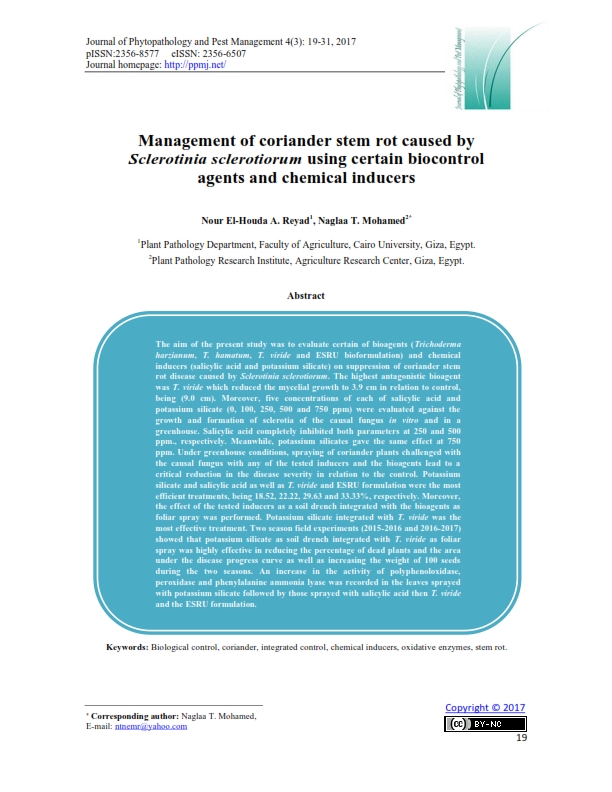Management of coriander stem rot caused by Sclerotinia sclerotiorum using certain biocontrol agents and chemical inducers
Keywords:
Biological control, coriander, integrated control, chemical inducers, oxidative enzymes, stem rot.Abstract
The aim of the present study was to evaluate certain of bioagents (Trichoderma harzianum, T. hamatum, T. viride and ESRU bioformulation) and chemical inducers (salicylic acid and potassium silicate) on suppression of coriander stem rot disease caused by Sclerotinia sclerotiorum. The highest antagonistic bioagent was T. viride which reduced the mycelial growth to 3.9 cm in relation to control, being (9.0 cm). Moreover, five concentrations of each of salicylic acid and potassium silicate (0, 100, 250, 500 and 750 ppm) were evaluated against the growth and formation of sclerotia of the causal fungus in vitro and in a greenhouse. Salicylic acid completely inhibited both parameters at 250 and 500 ppm., respectively. Meanwhile, potassium silicates gave the same effect at 750 ppm. Under greenhouse conditions, spraying of coriander plants challenged with the causal fungus with any of the tested inducers and the bioagents lead to a critical reduction in the disease severity in relation to the control. Potassium silicate and salicylic acid as well as T. viride and ESRU formulation were the most efficient treatments, being 18.52, 22.22, 29.63 and 33.33%, respectively. Moreover, the effect of the tested inducers as a soil drench integrated with the bioagents as foliar spray was performed. Potassium silicate integrated with T. viride was the most effective treatment. Two season field experiments (2015-2016 and 2016-2017) showed that potassium silicate as soil drench integrated with T. viride as foliar spray was highly effective in reducing the percentage of dead plants and the area under the disease progress curve as well as increasing the weight of 100 seeds during the two seasons. An increase in the activity of polyphenoloxidase, peroxidase and phenylalanine ammonia lyase was recorded in the leaves sprayed with potassium silicate followed by those sprayed with salicylic acid then T. viride and the ESRU formulation.Â
Metrics

Published
How to Cite
Issue
Section
License
Authors who publish with Journal of Phytopathology and Disease Management agree to the following terms:
- Authors retain copyright and grant the journal right of first publication with the work simultaneously licensed under a Creative Commons Attribution License that allows others to share the work with an acknowledgement of the work's authorship and initial publication in this journal.
- Authors retain copyright and grant the journal right of first publication with the work simultaneously licensed under the Creative Commons Attribution-Non Commercial License (CC BY-NC). This allows others to share the work with an acknowledgement of the work's authorship and initial publication in this journal.
- Archives of Agricultural Sciences Journal is an Open Access Journal, and articles published are distributed under the terms of the Creative Commons Attribution-Non Commercial License (CC BY-NC). Readers may copy, distribute, and display the work for non commercial purposes with the proper citation of the original work. However, the journal retains the right to exploit subsidiary rights on behalf of the authors.
- Authors are able to enter into separate, additional contractural arrangements for the non-exclusive distribution of the journal's published version of the work (e.g. post it to an institutional repository or publish it in a book), with an acknowledgement of its initial publication in this journal.
- Authors are permitted and encouraged to post their work online (e.g., in institutional repositories or on their website) prior to and during the submission process with full disclosure to the journal, as it can lead to productive exchanges, as well as earlier and greater citation of published work. Following publication in Archives of Agricultural Sciences Journal, the author should update the repository, and include a citation and link to the published work.
Click here for more information on Licensing policy
.png)




